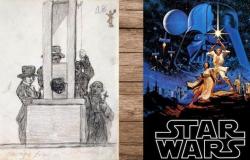We analyze Pantera’s discography from the worst to the best. From the glam of its beginnings to the groove metal of its maturity. Nine albums that transformed metal.
Now what Barcelona Rock Festival The exclusive confirmation of Panther as one of the headliners of the festival, it’s as good a time as any to review a discography varied and evolutionary like that of the combo of groove metal most popular on the planet. Their early retirement in the early 2000s left a seamless discography and an intact legacy that was only amplified by the murder of Dimebag Darrell and the feeling that the band had not said its last word musically. But, at the same time, Pantera avoided a certain decline that affects all groups at one point or another in their career. His legacy is intact, his legend too. Taking advantage of the fact that next July 6 we will be able to enjoy them in Barcelona for the first time in 24 years (which is said quickly) we take the opportunity to analyze their discography from the worst to the best.
“Metal Magic” (1983)
Pantera’s debut, “Metal Magic”, released in 1983, marked the beginning of one of the most influential bands on the heavy metal scene. This album, strongly rooted in glam metal, showed a very different facet of what Pantera would become known for in later decades. With a production that reflected the limitations of the time and the band’s budget, “Metal Magic” nevertheless distilled the energy and passion of young musicians searching for their place in the world of rock. The songs, loaded with melodic riffs and expressive guitar solos, evidenced the technical skill of Dimebag Darrell and a vocal style that Terry Glaze contributed, distant from the more aggressive approach that Phil Anselmo would bring later.
“Projects in the Jungle” (1984)
Just a year after their debut, Pantera released “Projects in the Jungle”, an album that continued in the vein of glam metal but with signs of evolution towards a harder and more complex sound. This work showed an improvement in production and compositions, evidencing the growth of the band as musicians. Although still influenced by the predominant rock trends of the ’80s, the lyrics and instrumentation were beginning to show a character of their own, with songs that stood out for their energy and Darrell’s growing prowess as a guitarist.
“I Am the Night” (1985)
With “I Am the Night,” Pantera takes another step toward defining its signature sound. Released in 1985, this album still contains elements of glam, but there is a clear transition towards a heavier and darker style. Terry Glaze’s stage presence and vocal abilities remain a key component, but it’s Dimebag Darrell’s guitar that begins to take a more prominent role, offering glimpses of the power and intensity that would define Pantera’s sonic future.

“Power Metal” (1988)
“Power Metal”, Pantera’s fourth album, marks a decisive turning point in the band’s evolution towards a more aggressive and technical metal. With the addition of Phil Anselmo as vocalist, Pantera embraces a more direct and powerful approach, definitively moving away from glam metal. This album combines the speed and power of thrash metal with the technique and precision that would become hallmarks of Pantera. The lyrics reflect a more serious and combative tone, and the performance shows a band that has found its unique voice, ready to challenge the limits of metal.

“The Great Southern Trendkill” (1996)
Pantera’s eighth studio album, “The Great Southern Trendkill”, represents one of the band’s most aggressive and experimental works. Released in a period where the musical landscape was beginning to become saturated with bands attempting to emulate Pantera’s signature sound, this album stands out for its defiant refusal to follow the predominant metal trends of that era. From the devastating scream that opens the album in the eponymous song, it is clear that Pantera was looking to explore more extreme and complex musical territories.
The album’s theme is dark and deeply personal, addressing issues of self-destruction, disillusionment and criticism of the music industry. Dimebag Darrell, the guitarist, displays one of his most innovative performances, mixing brutal riffs with experimental guitar solos that push the boundaries of the genre. The production of “The Great Southern Trendkill” also deserves mention, with its raw sound perfectly complementing the intensity of the compositions.
Among the standout tracks, “Floods” stands out for its emotional guitar solo, considered one of the best in metal history. This album not only established Pantera as one of the fiercest bands in metal but also demonstrated their willingness to innovate and resist being pigeonholed.

“Reinventing the Steel” (2000)
“Reinventing the Steel,” Pantera’s ninth and final studio album, serves as a powerful close to the band’s recording career. Published in 2000, this work encapsulates the essence of Pantera, fusing the intensity of its beginnings with the musical maturity acquired over the years. The album’s title reflects the band’s philosophy: constant reinvention and fidelity to its musical identity, without giving in to passing metal fads.
Musically, “Reinventing the Steel” offers a robust mix of crushing riffs, unstoppable rhythms and lyrical aggression that addresses themes of perseverance, integrity and social criticism. The production, performed by the band alongside Sterling Winfield, emphasizes a direct, unadorned approach, allowing the rawness of Pantera’s metal to shine without restraint.
Songs like “Revolution Is My Name” and “I’ll Cast a Shadow” stand out for their potent blend of groove and technique, demonstrating the band’s ability to create metal anthems with lasting resonance. “Reinventing the Steel” not only confirmed Pantera’s place in metal’s elite but also stood as a testament to their resilience against the pressures of an ever-changing industry.
Although “Reinventing the Steel” would be the final chapter in Pantera’s discography due to their dissolution in the following years, the band’s legacy and influence on metal remains unquestioned. Both albums, “The Great Southern Trendkill” and “Reinventing the Steel,” are crucial examples of how Pantera maintained its relevance and authenticity in a genre characterized by evolution and reinvention.

“Far Beyond Driven” (1994)
“Far Beyond Driven” takes Pantera’s musical extremism to new heights. Reaching number one on the Billboard 200 upon its release, this album defies any preconceived expectations about how far metal could go in terms of harshness and complexity. Songs like “I’m Broken” and “5 Minutes Alone” are brutal in their honesty and aggression, while “Planet Caravan,” a Black Sabbath cover, offers a melodic and atmospheric counterpoint. “Far Beyond Driven” is not only a milestone in Pantera’s career but also a benchmark for the transformative power of metal.

“Cowboys from Hell” (1990)
Considered by many to be Pantera’s true metal debut, “Cowboys from Hell” represents a revolution for both the band and the genre. Leaving behind any vestige of their glam past, Pantera immerses themselves in a sound that they themselves would call power groove. This album is a statement of intent, with impeccable production that highlights devastating riffs, a relentless rhythm section and the unmistakable voice of Phil Anselmo. Songs like the eponymous “Cowboys from Hell” and “Cemetery Gates” not only became metal anthems but also put Pantera on the world map.














